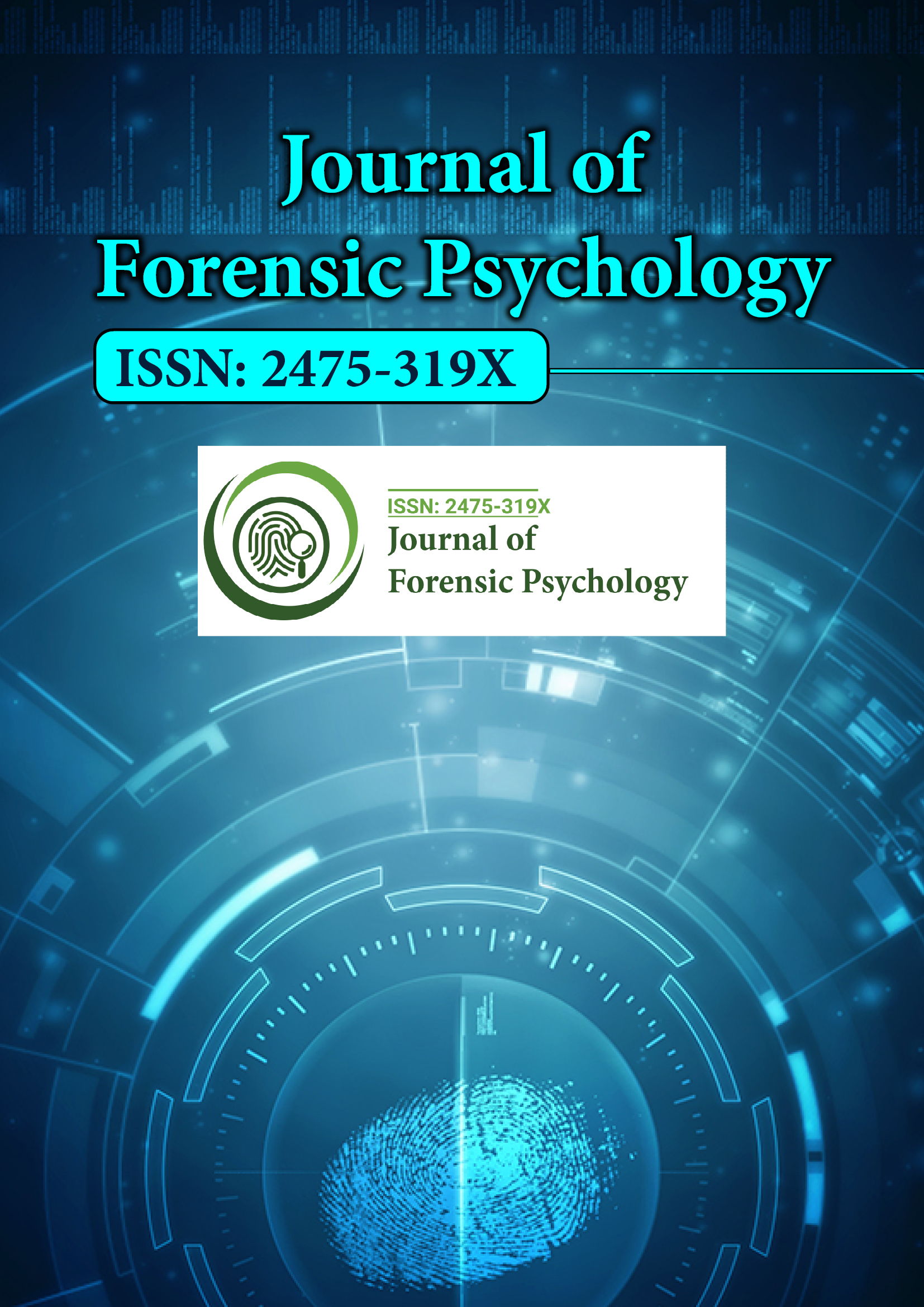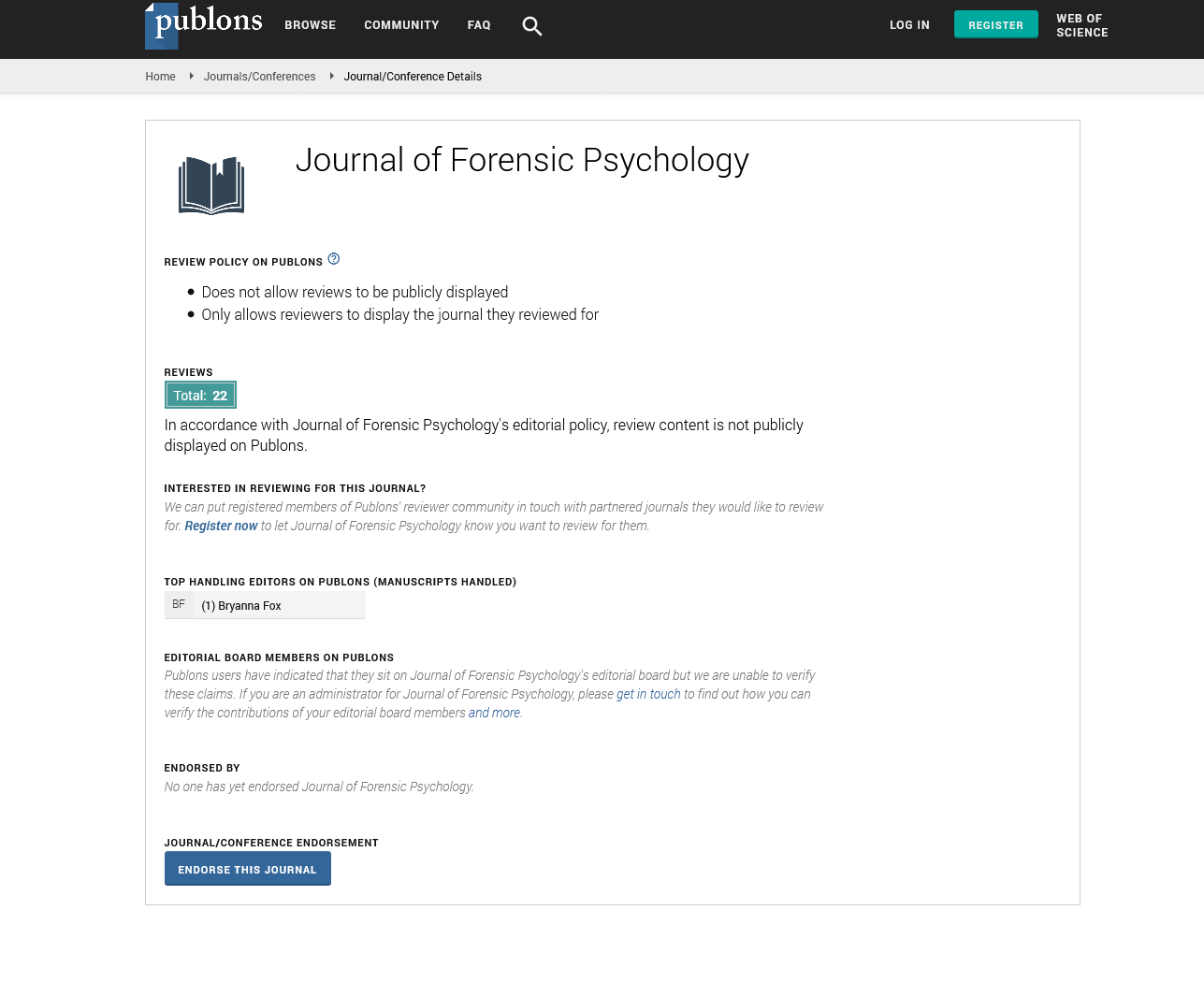Indexed In
- RefSeek
- Hamdard University
- EBSCO A-Z
- Publons
- Geneva Foundation for Medical Education and Research
- Euro Pub
- Google Scholar
Useful Links
Share This Page
Journal Flyer

Open Access Journals
- Agri and Aquaculture
- Biochemistry
- Bioinformatics & Systems Biology
- Business & Management
- Chemistry
- Clinical Sciences
- Engineering
- Food & Nutrition
- General Science
- Genetics & Molecular Biology
- Immunology & Microbiology
- Medical Sciences
- Neuroscience & Psychology
- Nursing & Health Care
- Pharmaceutical Sciences
Short Communication - (2021) Volume 6, Issue 7
Brief Note on Dissociative Identity Disorder
Robert A linin*Received: 09-Jul-2021 Published: 30-Aug-2021, DOI: 10.35248/2475-319X.21.6.178
Description
Dissociative Identity Disorder (DID) may be a rare disorder related to severe behavioral health symptoms. DID was previously referred to as split personality Disorder till 1994 [1]. It is a mental disturbance characterized by the upkeep of a minimum of two distinct and comparatively enduring personality states. The disorder is amid memory gaps beyond what would be explained by ordinary forgetfulness. The personality states alternately show during a person's behavior. Patients with DID accompany increased rates of non-suicidal self-injurious behavior and suicide attempts.
Etiology
DID is related to overwhelming traumas, or abuse during childhood. In about 90% of cases, there's a history of abuse in childhood, while other cases are linked to experiences of war, or medical procedures during childhood. Genetic and biological factors also are believed to play a task.
Person with symptoms of predisposing factors for dissociation, which include a capability to dissociate, overwhelming traumatic experiences that distort reality, creation of alters with specific names and identities, and lack of external stability, which results in the child's self-soothing to tolerate these stressors. These four factors must be present for DID to develop. The diagnosis shouldn't be made if the person's condition is best accounted for by substance use disorder, seizures, other psychological state problems, imaginative play in children, or religious practices.
Diagnosis
The thanks to diagnose dissociative identity disorder are via detailed history taken by both psychiatric practitioners and experienced psychologists. Longitudinal assessments over long periods and careful history taking are required to finish diagnostic evaluations. Neurological examinations are required as well to rule out autoimmune encephalitis, electroencephalograms, lumbar punctures, and brain imaging.
Dissociative Disorders are classically characterized as an interruption of normal consciousness/memory/identity and behavior. The disorders are classically weakened into "positive " and "negative" symptoms.
Positive symptoms are often related to "new personalities, decreolization,"
Symptoms are symptoms like autism and paralysis.
Some evaluation tools are developed to diagnose DID. Some of these are below:
Dissociative Experiences Scale-28-item self-report instrument whose items tap the absorption of outside information, use of imagination depersonalization, derealisation, and amnesia primarily.
Dissociation Questionnaire-63 questions that measure-measures identity confusion and fragmentation, loss of control, amnesia, and absorption.
Difficulties in Emotion Regulation Scale (DERS)-36-question subjective questions around challenges in goal-directed work, impulsivity, emotional responses to situations, ability to selfregulate emotions, etc.
Common treatment methods include an eclectic mixture of psychotherapy techniques, including Cognitive Behavioral Therapy (CBT), Insight-oriented therapy, Dialectical Behavioral Therapy (DBT) and Hypnotherapy and Eye Movement Desensitization and Reprocessing (EMDR). Medications can be used for comorbid disorders or targeted symptom relief, for example antidepressants or treatments to improve sleep [2,3].
Treatment
Therapy for DID is generally phase oriented.
The first phase of therapy focuses on symptoms and relieving the distressing aspects of the condition, ensuring the security of the individual, improving the patient's capacity to make and maintain healthy relationships, and improving general daily life functioning. Comorbid disorders like substance use disorder and eating disorders are addressed during this phase of treatment. The second phase focuses on stepwise exposure to traumatic memories and prevention of re-dissociation. The final phase focuses on reconnecting the identities of disparate alters into one functioning identity with all its memories and experiences intact.
Some of the treatment methods include
Dialectical Behavioral Therapy (DBT): The rationale DBT skills are used is actually secondary to a number of the overlapping symptoms between borderline mental disorder and DID. Even with varying therapy approaches- some core features of treatment include more education, emotional regulation, managing stressors, and daily functioning.
Hypnosis: DID patients are more hypnotizable than other clinical populations according to literature. There have been some studies as recent as 2009 that have shown efficacy in the use of hypnosis to treat DID. Many DID patients are considered auto hypnotic. Some techniques include accessing alternate identities not present within the session, an intervention which will facilitate the emergence of identities critical to the therapeutic process.
Eye Movement Desensitization and Reprocessing (EMDR): EMDR processing is suggested only the patient is usually stable and has adequate coping skills. EMDR interventions for symptom reduction and containment, ego strengthening, work with alternate identities, and, when appropriate, the negotiation of consent and preparation of alternate identities [4].
Psychopharmacology: It is not the primary treatment for DID. Medications could also be wont to target certain symptoms reported. Most commonly used medications include medications for mood disorders and PTSD (Post-Traumatic Stress Disorder) [5].
Conclusion
It is concluded that the treating Dissociative Identity Disorder with Psychopharmacological medications remain as different alters may report different symptoms and some alter may report compliance and some may not. Some studies have shown that many medications have been used for DID including antipsychotic medications, mood stabilizers, even stimulants however no medication has been effective in the treatment of Dissociative Identity Disorder (DID).
REFERENCES
- Brand BL, Schielke HJ, Putnam KT, Putnam FW, Loewenstein RJ, Myrick A et al. An online educational program for individuals with dissociative disorders and their clinicians:1 year and 2 year follow-up. J Trauma Stress. 2019;32(1):156-166.
- ISSTD I. Guidelines for Treating Dissociative Identity Disorder in Adults, Third Revision: Summary Version. J Trauma Dissociation. 2011;12(2):188-212.
- MacDonald K. Dissociative disorders unclear? Think ‘rainbows from pain blows’. Psychiatry. 2008;7(5):73-82.
- Fine CG, Berkowitz AS. The wreathing protocol: The imbrication of hypnosis and EMDR in the treatment of dissociative identity disorder and other dissociative responses. Am J Clin Hypn. 2001;43(3-4):275-290.
- Loewenstein RJ. Rational psychopharmacology in the treatment of multiple personality disorder. Psychiatr Clin North Am. 1991;14(3)721-740.
Citation: Linin RA (2021) Brief Note on Dissociative Identity Disorder. J Foren Psy. 6:178.
Copyright: © 2021 Linin RA. This is an open-access article distributed under the terms of the Creative Commons Attribution License, which permits unrestricted use, distribution, and reproduction in any medium, provided the original author and source are credited.

